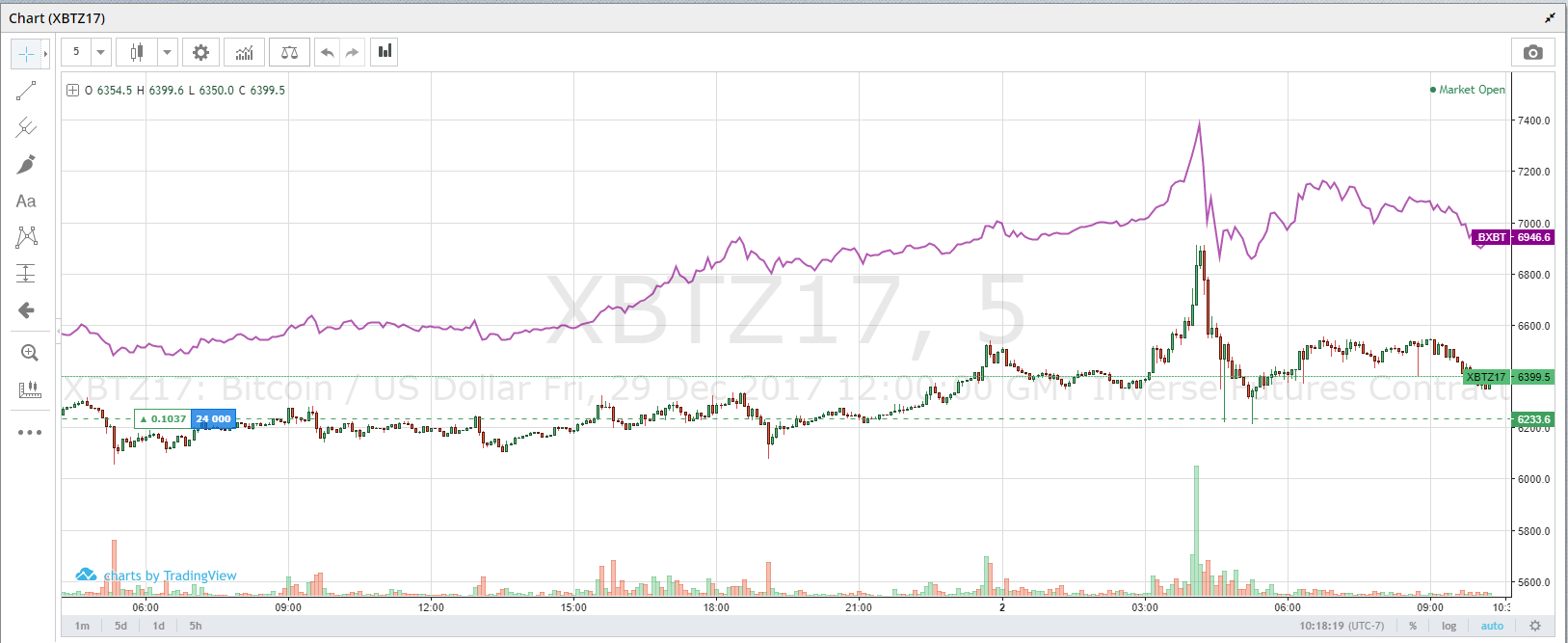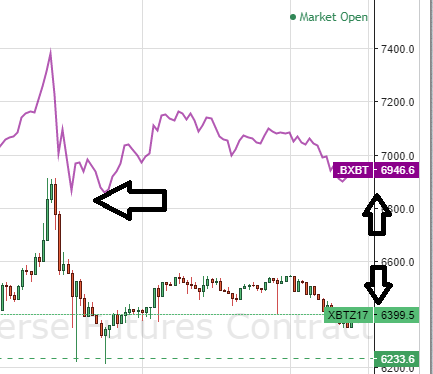Yesterday there was an absurd 8% spread between the price of Bitcoin and the Bitcoin futures contract price on Bitmex (world’s largest Bitcoin futures exchange).

I am showing a chart with a long y-axis to show the spread isn’t some aberration. The spread has been there for days and if anything, it is widening.
I’m going to tell you how to play this trade the professional way, not the way most investors are playing it.

As you can see, the price of Bitcoin in this snapshot is $6946.60 and the XBTZ17 contact is priced at $6399.50.
The XBTZ17 is the main futures contract of the Bitmex exchange. The XBT stands for the trading symbol of Bitcoin, and the Z17 stands for December 2017 (Z – last day of the month, get it?)
Contract is over, or “settles” on the last day when everybody is paid out according to the price of Bitcoin that day.
To repeat, that’s a spread of 7.9%, on a contract that is due to settle on December 29th, or in less than two months.
What is the explanation for this?
In mid-November, Bitcoin is expected to split again i.e. do a hard fork. This will be the third hard fork in less than six months. The code base will split like an amoeba and you will have two coins that should be worth more than the original coin. At least that is what traders are betting.
The discount is a combination reflecting traders’ fears of a disorderly hard fork, and traders selling XBTZ17 vs. buying spot to create SegWit2x coins with no Bitcoin price risk.
To put in another way, investors are selling short Bitcoin futures and buy Bitcoins on margin to get the “hard fork” dividend.
But the spread is so high that it’s amateurish to employ this type of trading strategy.
Let me explain:
Assume after the hard fork you have two coins, one Bitcoin and one Bitcoin Segwit2x coin (that’s what the hard fork is called, Segwit2x). It’s safe to assume that the spread between the price of Bitcoin and the futures contract disappears.
Assuming you have not used any leverage on Bitmex (if you did, congrats, you compounded your losses), you put one Bitcoin on Bitmex and one Bitcoin on an exchange that supports the split (not all do).
If the experience of Bitcoin Cash is anything to go by, you will get a 25% dividend – as long as you sell as quickly as the coins are issued.
But your return on total investment must be calculated on the two Bitcoins you had to invest, minus the 8% you lost on Bitmex. Therefore:
Return on investment = (1.25 + 0.92)/2 or 8.5%. Not bad for two weeks work.
But there is a better way.
For a professional derivatives trader, a standard tool in his toolbox is the cash-and-carry trade. I’m not going to explain it to you in this article, either follow the link to learn more, or better yet, sign up to receive my newsletter and I will email you the details of doing cash-and-carry trades on the Bitmex exchange.
What we have here is a reverse of a cash-and-carry and it’s a beautiful thing.
Let’s pretend we have bought X Bitcoin futures contracts leveraged at 5-to-1. We put down one Bitcoin and leverage up to 5X Bitcoins.
We wait less than two months and the XBTZ17 contract settles at the market price of Bitcoin that day. But really that’s worst-case scenario. In reality we can settle this trade by November 20th at the latest.
Assuming the price of Bitcoin stays the same, you have made a return of 7.9% times 5 = 39.5%.
Aha, you say but what if the price of Bitcoin goes down? To answer that questions, this is where you carry out the second part of the cash-and-carry.
You turn to your margin account on Kraken or Bitfinex or Coinbase (cryptoexchanges that allow short-selling with margin) and sell short at 4-to-1 (you can’t get 5-to-1). To cover yourself, you need to put up an additional 1.25 Bitcoins.
Now your return on your investment, which is fully hedged, is 39.5% / 2.25 which equals 17.5%.
This is completely hedged and risk-free.
In other words, you don’t have to worry about your investment or watch it every or read the news in case some bad event happens and you have to react, you just go surfing or book a wine tour for two months and show up on December 29th, 2017 at the latest to collect your money.
The other trading strategy has a LOT of risk as there is no guarantee that the new coin will give a 25% dividend AND you need to be able to sell it right away to lock in your gain.
Lastly, it doesn’t pay as much.
These are the types of trades and storylines I publish regularly. In early 2018, these timely trades and detailed market background will become a paid subscription service. My blog will still have regular free stories on trends and happenings in the crypto world (and in the public market stocks that get involved), but monetizing that knowledge…will be for a select few.
I hope you will join me! Until then, please enjoy our entire website.
